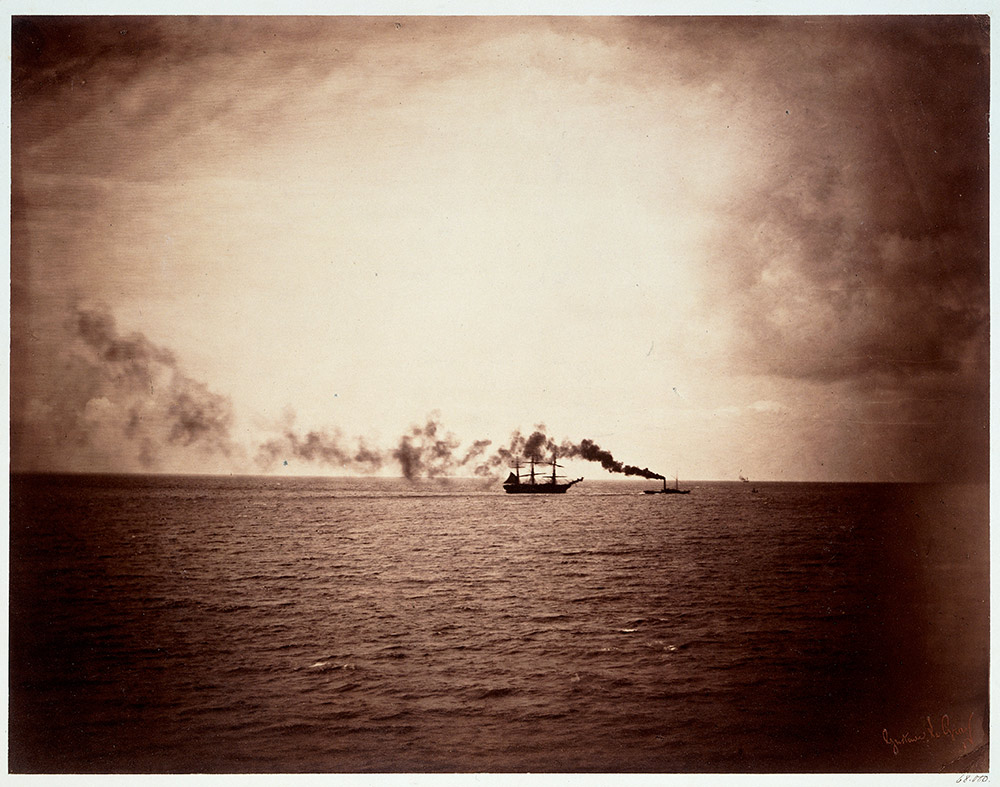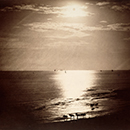Gustave Le Gray
‘Since its first discovery, photography has made rapid progress, especially as regards the instruments employed in its practice. It now remains for the artist to raise it to its proper position among the fine arts.’
Gustave focused on sea and sky photography. Born in Paris (1820) and trained to be a painter, 27 years later he started doing photography. Even before making the marine images, he became one of the most renowned pioneers of the new art. His architectural, landscape and portrait photographs, his writings, teaching and inventions were all highly influential.
The great wave

The Great Wave, the most dramatic of his seascapes, combines Le Gray’s technical mastery with expressive grandeur. He took the view on the Mediterranean coast near Montpellier. At the horizon, the clouds are cut off where they meet the sea. This indicates the join between two separate negatives. The combination of two negatives allowed Le Gray to achieve tonal balance between sea and sky on the final print. It gives a more truthful sense of how the eye, rather than the camera, perceives nature. When first shown, the luminous, shimmering effects amid Le Gray’s otherwise dark seascapes were often mistaken for moonlight. It is easy to see why this misconception arose in these monochrome images where darkness encroaches towards the edges of the scene. In fact, he achieved the moonlight effect by pointing the camera in the direction of the sun during daylight.






It was not only their beauty that attracted high praise but also Le Gray’s technical mastery in capturing apparently instantaneous views. To arrest breaking waves was an impressive accomplishment at a period when exposures required many seconds rather than split seconds.
Most photographers found it impossible to achieve proper exposure for both landscape and sky in a single picture. This usually meant sacrificing the sky, which was then over-exposed. Le Gray’s innovation was to print some of the seascapes from two separate negatives – one exposed for the sea, the other for the sky – on a single sheet of paper.
Dafner talmor
Dafna Talmor is a visual artist that took abstract photographs. She is an artist that lecturers based in London whose practice encompasses photography, spatial interventions, curation and collaborations. Her photographs are included in public collections of Victoria and Albert Museum, Deutsche Bank, Hiscox and in private collections internationally.

Comparing both landscapes:
Similarities and differences
Both show the beach and the waves. However, Le Gray’s is more obvious as it’s how a usual landscape looks and is easy for people to quickly recognise that it’s a landscape. Whereas Talmor’s is more abstract and is like a collage, picking apart different landscapes, this is more creative. If I had to choose which landscape I’m drawn to the most it would be Talmor’s as it gives off a sense of mystery where you haven’t got the full image, instead just the cut-out parts of the image, but can use your imagination and ‘put the pieces’ together.
